So you’ve found your way to the Base – Fossil format, huh? Welcome!
Base – Fossil (read as Base to Fossil) is a format comprised of the first 3 sets in the Pokémon TCG; Base Set, Jungle, and Fossil. Each set brought something new and exciting to the game, culminating in the fun, interesting, and skill expressive format that we know and love.
I won’t go into extensive detail and complete depth of the entire format here, but you can find out everything there is to know by checking out Jason Klaczynski’s blog, where he does an excellent job of explaining the format and its history!
(Link here: The Era of Big Basics: 1999’s Base–Fossil Format – Retro Pokémon TCG )
Alright, let’s jump right in! This is an in-depth article about my personal Base-Fossil Gauntlet (or battle box as some people call it). I’ll show you the 9 decks I’ve chosen, why I’ve chosen them, and a brief run-down for each one. I’ve also included an honorable mention to a 10th deck and references to the other decks in the format that didn’t quite make the cut.
My Base – Fossil gauntlet has been specifically designed in a way that balances power and playability to create an environment of interesting and skill expressive games, while simultaneously making sure each deck is both streamlined enough to be beginner friendly, but also teched out enough to keep experienced players coming back for more!
The goals for this project were to showcase the most iconic cards and powerful decks of the format, while keeping the power level of the enclosed metagame as even as possible, ensuring the largest majority of games played feel balanced and enjoyable, time and time again.
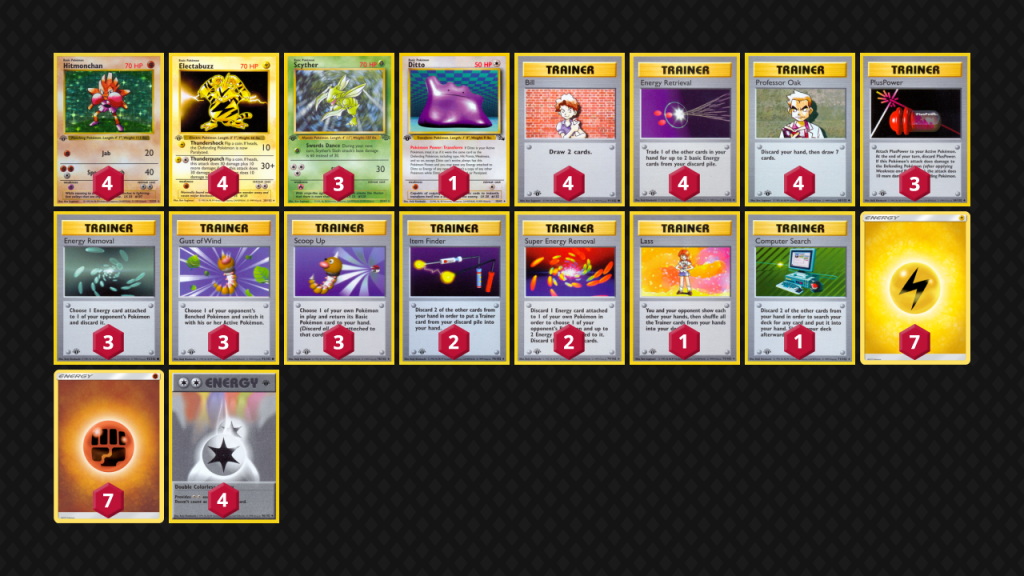
Let’s start at the beginning, in every sense of the word. This is Haymaker, the most iconic and well-known deck of the ‘99 era. In the modern era of the Base – Fossil format, this deck is often referred to as “TradMaker” or Traditional Haymaker.
Haymaker was far too iconic not to be included in this project, however the deck that was once touted as “The Best Deck in the Format” during the ‘99 era had to make some changes to keep up with the times. The boxing legend no longer finds himself at the top of the food chain, instead finding himself as just one of the many key players of the format.
While Hitmonchan’s 20 damage for one fighting energy is still the best going rate in the format, our friend finds himself resisted by Scyther, Dodrio, and Articuno. Additionally, Hitmonchan carries an unfortunate weakness to Psychic, one of the most powerful types in the format. It’s not all woes and sorrows though, Hitmonchan does a great job of hitting for weakness against Lickitung, Electabuzz, Chansey, Wigglytuff, and Kangaskhan!
Speaking of Electabuzz, you’ll find that our sparky friend here has actually aged quite well. Not only is 30+ damage for two energy from Thunder Punch still a great rate (in addition to the paralysis from Thundershock), but hitting for weakness against the likes of Dodrio and Blastoise is extremely helpful as well. It’s also worth noting that nothing meta-relevant boasts a resistance to Lightning!
Additional Pokémon in the deck include Scyther, who resists opposing Hitmonchan, attacks for any type of energy, and has free retreat; as well as Ditto, who acts as both our counterplay to Mewtwo and a flexible attacker in various scenarios thanks to its unique ability that turns any energy attached into Rainbow Energy!
TradMaker is the textbook definition of true aggro, but that doesn’t mean we can’t be smart about it. This list packs three Gust of Wind to help Hitmonchan find his way into favorable match ups and a 2-2 split of Switch and Scoop Up to help find his way out of unfavorable ones. Scoop Up doubles as a way to heal off damage, while Switch allows you to leave the active spot (even through status conditions) while also maintaining energy in play, an important part of the Base-Fossil format! In fact, this list is actually designed with energy conservation (and mobility) in mind, which is why we only play two copies of each Scoop Up and Super Energy removal.
This decklist was finalized on 11/5/2025
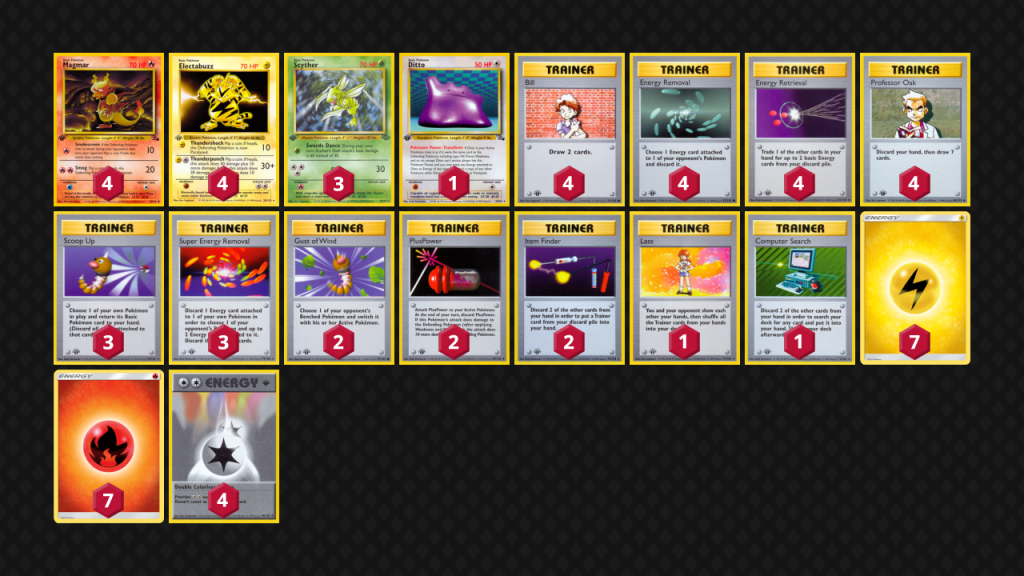
Moving on to a variation of the aforementioned TradMaker deck; “New Maker” (as I call it) was designed as the successor to the original Haymaker deck. Choosing to swap out Hitmonchan for the Fossil printing of Magmar. While Hitmonchan found himself resisted by the now omni-present Scyther, Magmar actually hits Scyther for weakness!
Since nothing meta-relevant boasts a resistance to Fire (or Lightning), switching Pokémon in and out of the active spot isn’t as important with this deck as it is with TradMaker, in fact Magmar would actually prefer opposing Pokémon stay trapped in the active spot since the Smog attack can result in the Poison condition, which will slowly eat away at the opposing Pokémon’s HP.
Additionally, Magmar retreats for only a single energy, whereas Hitmonchan requires two. This allows the deck to play a little bit looser with its energy attachments, giving us the flexibility to play the 3rd Scoop Up and the extra copies of (Super) Energy Removal, both of which lend themselves well to Magmar and Electabuzz’s play pattern of status conditions and longer, slower games. NewMaker plays more like a midrange deck than its aggro-aimed predecessor and that shows in the deck’s design!
This decklist was finalized on 10/15/2025
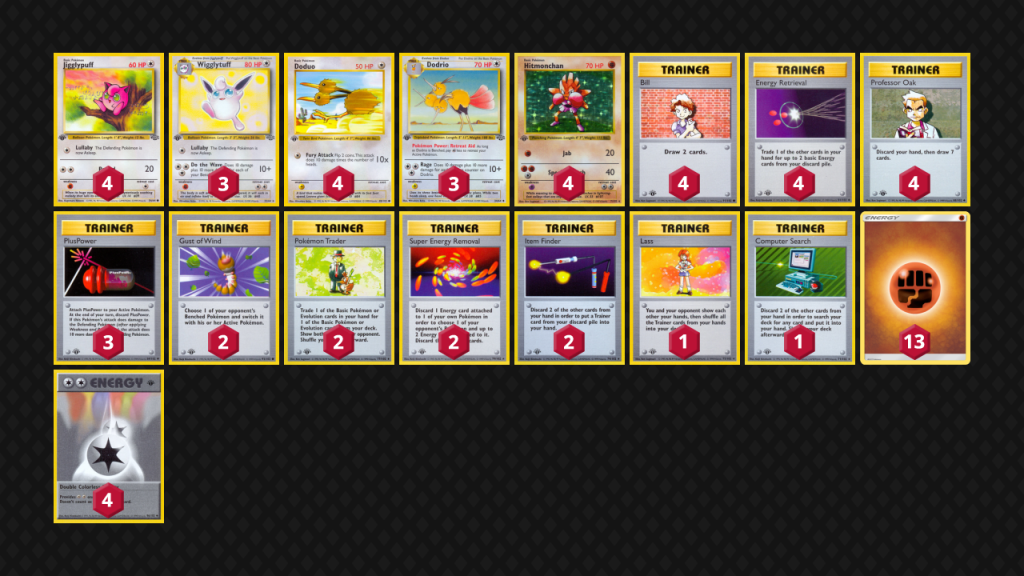
Behold, the evolution of aggression! This is “DFW” or Dodrio + Fighting + Wigglytuff. (Please excuse the naming conventions, we’re not really sure how they got started either…) This deck introduces you to two more major players in the Base – Fossil format; Wigglytuff and Dodrio.
Wigglytuff is one of the few Evolution Pokémon that can not only hang with the big basics of the format, but she can also give them the smackdown! Wigglytuff’s Do the Wave attack does 60 damage with a full bench and 70 damage with a PlusPower, that’s the magic number for one hit knock outs on Pokémon like Hitmonchan, Electabuzz, and Mewtwo – just to name a few!
Jigglypuff is no slouch either, using the Lullaby attack to put the opponents active Pokémon to Sleep can buy precious turns while trying to build up your boardstate. Dodrio is a discovery accredited to more modern times. Players realized that its powerful ability allowed for infinite retreats, so long as you had enough Dodrios on the bench to cover your active Pokémon’s entire retreat cost. This allows them to easily pivot out of unfavorable situations, such as Wigglytuff facing Energy Removals or Hitmonchan facing resistance. An easy swap to the bench means someone else can take their place and keep the pressure on!
One of the best parts of this deck is the type coverage it provides. Hitmonchan is weak to Psychic, but Wigglytuff resists it, and while Wigglytuff is weak to Fighting, Dodrio resists it. Lastly, Dodrio is weak to Lighting, but Hitmonchan can hit Lightning types for weakness!
This deck also plays a 3-2 split of PlusPower and Gust of Wind, giving you the ability to take KOs easily and often! While one Lass gives you a fighting chance against Energy Removal heavy decks, two Super Energy Removals of your own lets you keep opposing threats neutralized, and a 2-1 split of Pokémon Trader and Computer search gives you that little bit of extra consistency.
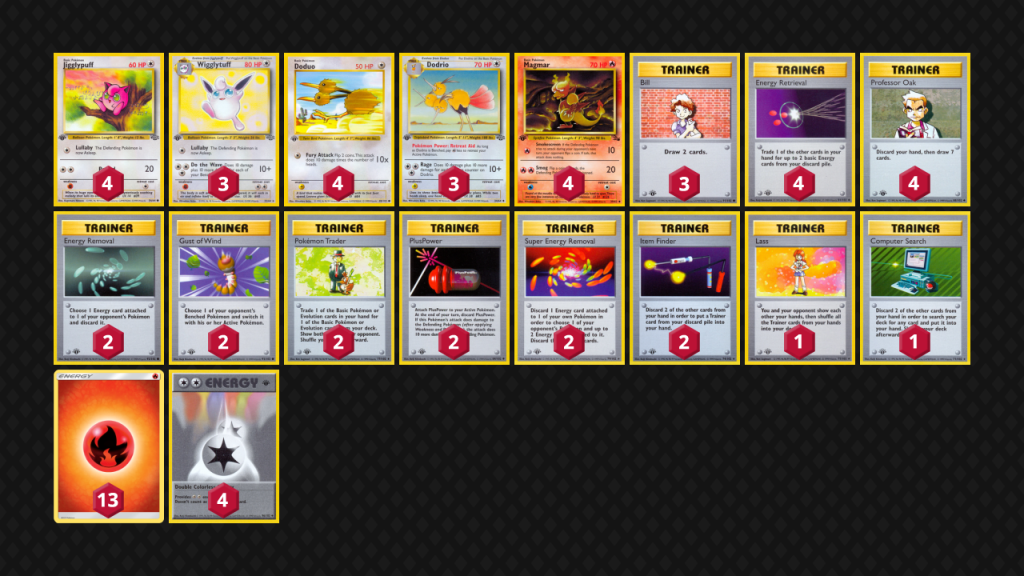
This is “WigMar” or Wigglytuff + Magmar. This deck takes a page right out of NewMaker’s playbook. Choosing to swap out Hitmonchan for the Fossil printing of Magmar, and for similar reasons. Magmar’s Smokescreen attack provides an extra way to buy time, this paired with two more Energy Removal lets the deck slow the game down to a crawl, choosing to build-up its threats slowly on the bench, instead of rushing the opponent head-on.
While WigMar doesn’t have the aggression or the type coverage of its predecessor, the extra status conditions and extra Energy Removals mean that this deck doesn’t just survive on the backfoot, it thrives! Don’t let this short deck description fool you, Magmar variants are some of the best decks to play with in the Base-Fossil format, as they typically have the most even match-up spreads available!
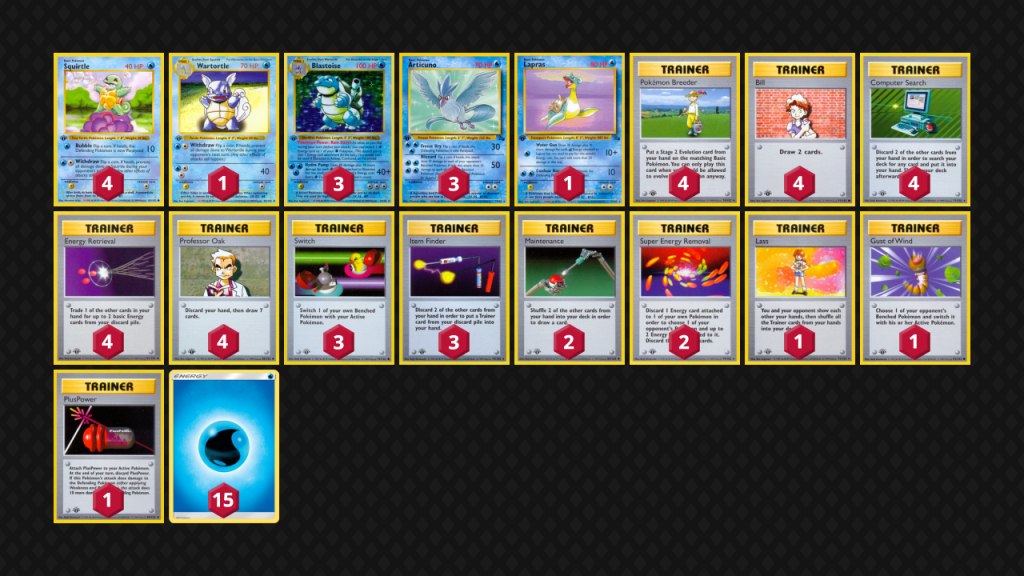
“Rain Dance” or Blastoise, is one of my favorite archetypes in all of Pokémon, it just had to be part of the collection! This deck is designed to go “all-in” on the combo of turn-two Blastoise via Pokémon Breeder. This allows you to flood the board with extra energy and try to win before the opponent can even get set up.
While Rain Dance is a very powerful ability, the deck can sometimes struggle with consistency issues (although we try our best to mitigate that by playing the maximum number of our consistency cards).
At first glance, the primary use of the “Maintenance” card specifically might not be obvious, but it’s actually used to “Protect” (or “Save”) cards in your hand from your own Professor Oak. Drawing seven fresh cards is really good, but discarding your Blastoise, Pokémon Breeder, and Energies is really bad. Maintenance lets us “Tuck” those cards back into our deck so that we can Oak without fear!
Once Blastoise is set up, you can use Rain Dance to accelerate into Articuno’s powerful attacks! With no weakness and a resistance to Hitmonchan, Articuno is the premier attacker in our deck. However, it’s worth noting that a Blastoise with 5 Energy and a PlusPower hits for 70 damage (a number that we’re already familiar with). While Lapras’s Water Gun attack gives us a fighting chance at breaking through Mr.Mime’s Invisible Wall, this deck also has the added benefit of being the only deck in the gauntlet that can hit Magmar for weakness.
Rain Dance is the type of deck that TCG communities would call an “80/20” deck; the first 80% of the deck’s power is easy to learn, but the last 20% takes time, patience, and experience. Do you have what it takes to join forces with Blastoise and become a true Pokémon Master?
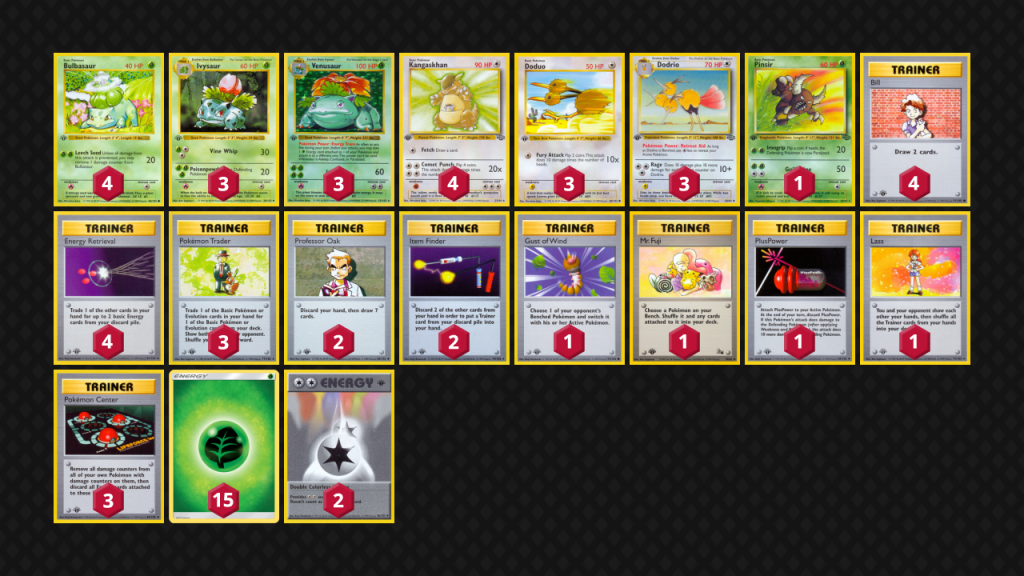
One good starter Pokémon deserves another, or so they say. This is “VenuCenter” or Venusaur. VenuCenter is a naming convention based on the deck’s two key components, Venusaur and Pokémon Center. Though every card in the deck carries its own weight. Most notably Kangaskhan’s Fetch attack allows us to draw through our deck, finding our evolution lines and our supporting cast of Trainers.
While Blastoise is a combo deck that aims to end the game as quickly as possible, Venusaur is a combo deck that aims to drag the game on as long as possible. Using the Energy Trans ability of Venusaur, paired with Pokémon Center, you can move your energies around anywhere on your board, allowing you to use Pokémon Center to heal off damage, without the downside of discarding Energy cards, so long as you move all those Energy cards to an un-damaged Pokémon first.
The abilities of Venusaur and Dodrio combined also gives you an extraordinary amount of agency over your board state, making sure every Pokémon and every Energy is in the most optimal position at all times!
While VenuCenter is a Tank & Heal deck through and through, PlusPower allows Venusaur to hit for 70 damage (a number that we’re already familiar with).
The primary strategy of this deck is to keep the Energy cards as spread out as possible on the turns that you’re not attacking, this lets you play around opposing Super Energy Removals. Additionally, once you’re ready to attack, Lass can clear the opponent’s hand of those pesky Energy Removals!
The last trick this deck has up its sleeve is preventing its own deck-out with Mr.Fuji. “Decking-Out” is a common Win/Lose condition in the Base-Fossil format and is actually how a decent portion of games are decided. Venusaur’s ability lets you move all of your energies onto a single Pokémon and then Mr.Fuji will shuffle that Pokémon and all of those attached cards back into your deck, giving you a much larger deck count in the late game than your opponent! This list was edited on 11/5/25
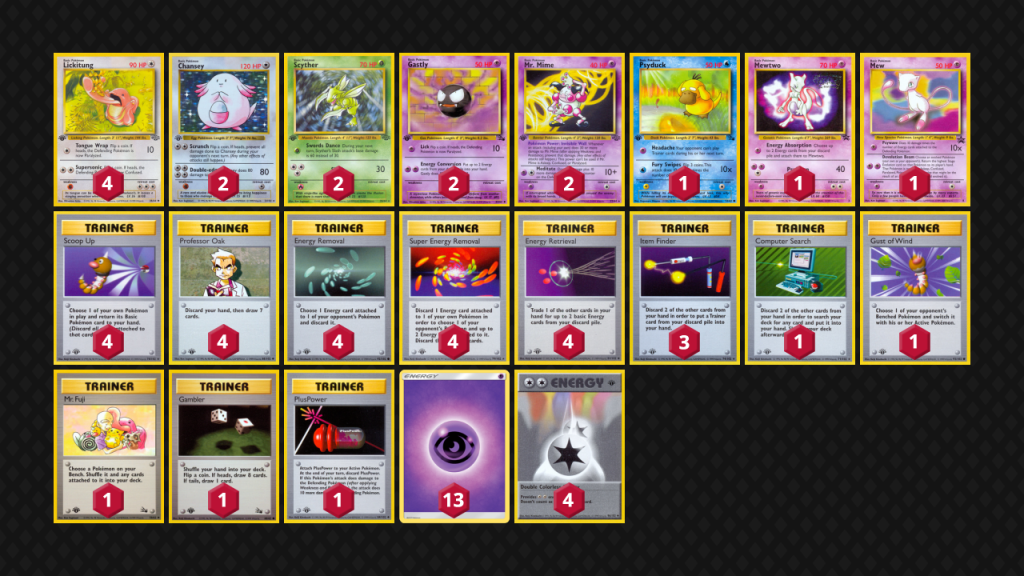
We’re finally here, the villain of the format by many people’s description. “PsyStall” or Psychic Stall is the premier control deck of the format. Lickitung is yet another discovery accredited to more modern times. Players realized that Lickitung’s attacks, paired with its big HP, made it an excellent choice for stalling out the game. An effective win condition when most decks at the time were flying through their resources with things like 4 Computer Search and only minimal amounts of recursion.
The only downside is that Lickitung carries a weakness to one of the best attackers in the format, Hitmonchan. Though this weakness is perfectly covered by the partners that Lickitung chooses to employ: Scyther resists Hitmonchan, while Gastly, Mr.Mime, and the Mew siblings all attack Hitmonchan for weakness.
Firstly, why is Stall such a good strategy, and how do we execute that strategy? Base-Fossil lends itself well to the Stall archetype, since the damage output is low comparatively to the HP of the format. Additionally, every deck is composed exclusively of Single Prize Pokémon, since this is long before multi-prize Pokémon came into existence. Combine that with nearly every deck in the format playing some number Energy Removal cards, and you have an ideal environment for Stall to thrive! The deck functions with a very high synergy, forcing multiple “layers” for the opponent to deal with. An army of status conditions, mixed resistances, high HP, and even special abilities (such as Mr.Mime’s Invisible Wall), already make the Pokémon themselves hard to deal with as it is. Pair that with the full 8 copies of (Super) Energy Removal and the healing capabilities of Scoop Up + Pokémon Center, and you can see what makes this deck such a formidable force!
The last piece of the puzzle is preventing your own deck-out. You can accomplish this in two ways, one of which is to repeatedly use Mewtwo’s Energy Absorption attack to attach a plethora of energy cards to itself, then send it back into the deck with Mr.Fuji. The other way is to use Gastly’s Energy Conversion attack to fill your hand up to 9 or more cards (preferably up to 15+), then use Gambler to shuffle your hand back into your deck. That way, even if you flip heads and draw 8 cards, you’ve still added cards to your deck count for the late game.
Secondly, how do we actually beat Stall, when it feels like the perfect storm? Playing with and/or against Stall are some of the most interesting games that the Base-Fossil format has to offer. Each side trying to exploit the opposing weaknesses while simultaneously trying to protect their own! Stall is a slow deck, the entire game plan is focused on slowing the game down as much as possible, this is an exploitable weakness by anything fast enough to capitalize on it. While Stall is the Champion of the late game, its early game leaves a lot to be desired. Hitting it hard and fast will be one of the best approaches, just be sure not to over-extend your resources!
Additionally, the healing capabilities of Stall don’t mean much of anything if you can just knock out their active Pokémon in one hit with the likes of Chansey or Wigglytuff. The last approach is just to play the long game with them. They can’t apply a status condition to you, if you apply a status condition to them first. Likewise, you can try to fire off your own Gambler and/or Mr.Fuji in the late game to keep your deck count higher. Just watch out for their Psyduck, since its Headache attack can lock-out Trainers, preventing you from playing the aforementioned cards.
Overall, playing with and/or against Stall has a lot of nuances to it, which is a big draw-in to a lot of players. Don’t let that intimidate you though, the deck is easy enough to pick up and learn with just a few games. This list was edited on 10/10/2025
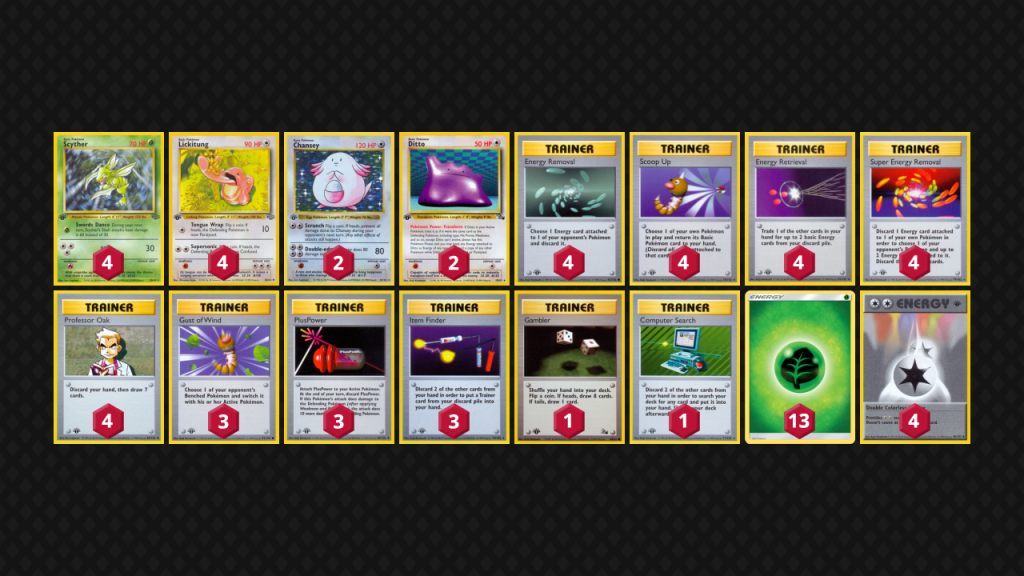
When I was a little kid, Scyther was my favorite Pokémon (second only to Charizard), I thought they were the coolest! But enough about me, this is “Grass Stall” and much like PsyStall, control is the name of the game. However, you may notice that this version of Stall looks much more linear and… aggressive? That’s right, we’re using Knock Out’s as both energy denial and another win condition!
While it’s commonplace for more traditional Stall decks to pair Scyther with Lickitung (covering the fighting weakness), they typically only take KOs to remove energy off the board or remove the biggest threat to their game plan (usually Mewtwo or Wigglytuff). Grass Stall doesn’t play by those rules. Packing all Grass Energy and a 3-3 split of PlusPower and Gust of Wind, we’re looking to Swords Dance all over our opponents!
This is still a control deck at heart, and a large part of your game plan will still be to slow the opponent down and run them out of resources. This deck is a master of turning the corner, fully capable of putting the foot on the gas at a moment’s notice!
More traditional Stall decks will play a more technical game, with scenario specific one-ofs, but what Grass Stall lacks in finesse, it makes up for with consistency and explosiveness. This version of Stall is easier to pilot while still being a ton of fun. “Scyther, use Slash attack!”
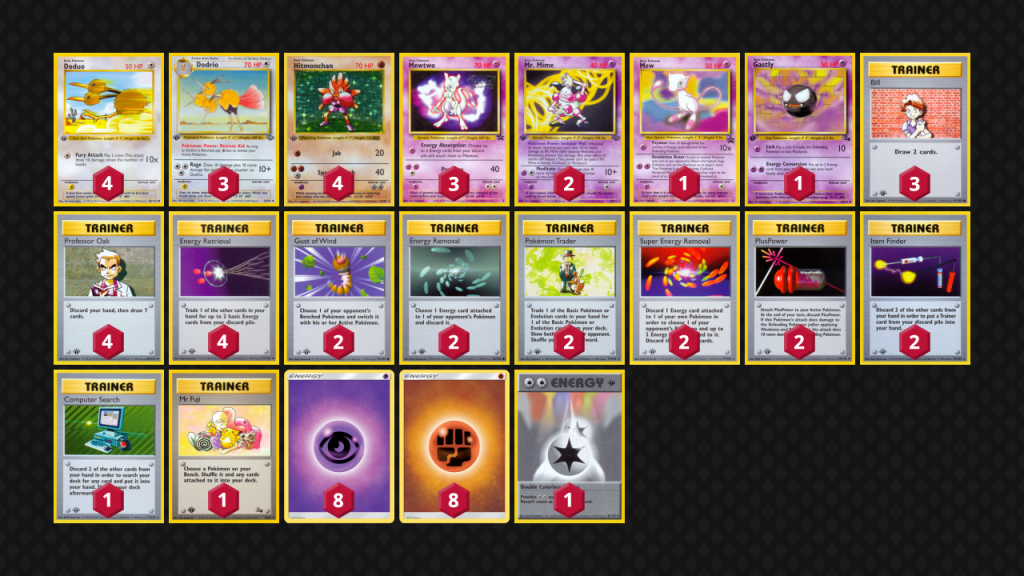
Did someone say, “turn the corner”? Welcome to “DFP” or Dodrio + Fighting + Psychic. This deck is the textbook definition of midrange. Pairing the “DF” package alongside Psychic Pokémon allows for offense and defense whenever either is needed. Truly the most flexible deck in the format, not even the deck list is unanimously decided upon!
This deck’s strength is its unwavering adaptability, having the tools necessary to navigate out of (or into) any given situation. By now, you may be familiar with both halves of this deck, however, putting them together creates entirely new play patterns.
Since Psychic is weak to Psychic in this era of Pokémon, one of the best ways to cover Hitmonchan’s weakness to Psychic, is with your own Psychic-type Pokémon (that’s a lot of Psychic, my head hurts).
This deck will reward you for picking up on the nuances of other decks prior, such as using Gastly’s Lick attack to set up perfect math for later on, or using Super Energy Removal to neutralize attackers that can break through Mr.Mime’s Invisible Wall (such as Lapras, or Bulbasaur).
Dodrio decks are notoriously well known for their ability to pivot, and this deck is no exception. It’s not uncommon for this deck to alternate between Hitmonchan + Gust of Wind and Mewtwo + Energy Removal.
If you embrace the initial learning curve, this is a deck that you’ll enjoy playing time and time again. This list was edited on 11/5/2025
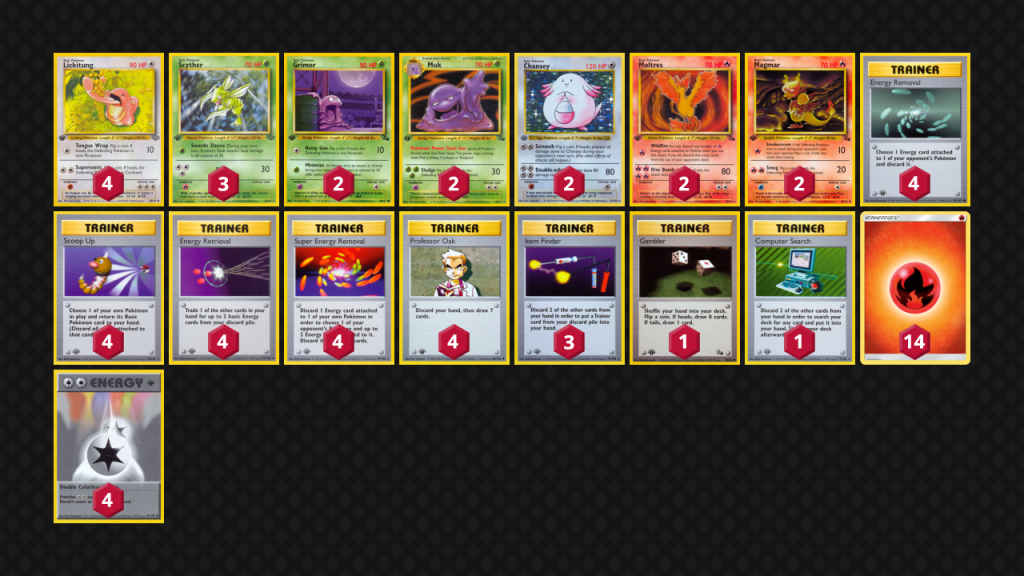
Honorable Mention: “Fire Stall” or Lickitung + Moltres. While I chose to only include 9 decks in my Base – Fossil gauntlet, I’d be hard pressed not to at least mention this one. I omitted this deck from my gauntlet because I felt as though adding it would have resulted in more overlapping cards and archetypes than I was willing to allow.
Fire Stall was a deck designed (to my knowledge) by Jason Klaczynski himself. Magmar serves as an additional status inflicting Pokemon, and actually pairs well with Lickitung if you can sequence Confusion into Poison. Jason was ahead of his time here, adding Muk into the deck. Not only does Grimer serve as yet another status inflicting Pokemon, but Muk’s Toxic Gas ability was a brilliant include, turning off the abilities of opposing Dodrio and Ditto, two Pokemon that Stall is known to struggle against. While Moltres’s Wildfire attack is a more aggressive way for stall decks to close-out games, the fire-bird also boasts a resistance to Hitmonchan.
This deck has seen many evolutions over the years, most recently (at the time of writing this article), Luke Townsend won Brew City Showdown 2 with his version of the deck. Luke dropped the Muk package entirely, choosing instead to play a few copies of Ditto. (Link to the tournament results here: Standings: B.C.O.S.S II Day 1 (Base–Fossil) Milwaukee, WI USA | Limitless )
That’s all 9 decks that made the cut and the one that barely missed! Now let’s take a quick look at all the other decks that missed by a long shot (and why).
Aerodactyl (and Mewtwo): This was a deck that felt bad in every single game that we played with it. Finding the Mysterious Fossil fast enough is already a challenge, but even when Aerodactyl does get set up, the deck still feels exceedingly underwhelming. Muk is the better choice over Aerodactyl and even Muk has its own issues.
Alakazam: This was a deck that was actually in the original gauntlet, however its low consistency paired with its low damage output and high retreat costs on most of the Pokémon ended up resulting in so many non-games that it wasn’t an enjoyable inclusion. Venusaur proved to be the strictly better tank and heal deck.
Arcanine (and Electrode): Another deck that was in the original gauntlet, however its low consistency paired with its inability to actually stay relevant as the game went on (even with “The Combo” properly executed, you could still lose in a variety of ways with ease) resulted in the deck feeling fun and exciting for the first couple of turns of the game but taking a very steep decline immediately thereafter. Rain Dance proved to be the strictly better combo deck.
Other Dodrio + Fighting variants: Charizard might be my favorite Pokémon of all time but that doesn’t change the fact that the DF-Zard deck felt so incredibly inconsistent and difficult to pilot that I’d never feel comfortable handing it to a newer or more casual player.
Clefable is a Pokémon that sees a lot of success in the Prop 15/3 format but struggles to maintain any kind of relevancy in the Base-Fossil format. FableMaker is only good in very particular environments, and this isn’t one of them.
Dragonite + Hitmonchan (or “Big Stepper”) is another deck that was in the original gauntlet, however its low consistency paired with its awkward attackers and inability to win games (even against favorable matchups) caused this deck to lose its place in line. I’m sorry friend, but you can’t Step-In this time.
Drought variants: Both Dragonair and Golduck have seen fringe play for their Hyper Beam attacks, which discard energy from the defending Pokémon. This paired with the full 8 copies of (Super) Energy Removal creates a strategy where you try to clear out every single one of your opponent’s Energy cards (or “Drought” them). The ironic downside here is that both Hyper Beam attacks have hefty energy costs of their own, and as such, aren’t viable in a format full of the aforementioned Energy Removals. Drought decks almost always find themselves forced to attack with their low-energy requirement Pokémon instead, such as Lickitung. More typical Stall variants proved to be the strictly better control decks.
Exeggutor (or “Eggs”): Not including this deck in the gauntlet was painful for me. I spent so much time playing so many versions of this deck, but they all had the same problem. The games where you get to “Do The Thing” are so incredibly fun and satisfying, it’s almost easy to forget how miserable you are trying to play the deck when it’s not functioning. Or rather, it would be, if that wasn’t the case for most of your games. Sadly, we decided that this deck had too many non-games to justify its inclusion in the battle box, but if you’re a casual player looking for a silly fun deck that doesn’t mind consistency issues, this is the one for you!
Gengar: This is a deck that we tried to justify including in the battle box for its iconic status alone, unfortunately the deck faced too many issues in playtesting and couldn’t make the cut. Its low consistency and awkward attackers caused the deck to get wall-stalled too often and too easily, resulting in too many non-games.
Mewtwo & Electabuzz (or “Sponge”): This deck is simply a case of something that didn’t age well into the modern era. While Sponge was a force to be reckoned with back in the ‘99 era of the Base-Fossil format, more recent innovations have created an environment that’s just too hostile for the Psychic and Lighting pair to consistently compete. Magmar variants proved to be the strictly better midrange decks.
Slowbro: This is another deck that I’m not actually against in some cases, Slowbro is a fun and interesting deck. It just didn’t find its way into the battle box because I tried to avoid having too much overlap, and it’s strictly worse than PsyStall & Venusaur at their respective archetypes (Stall and Tank & Heal). Like Exeggutor, if you’re a casual player just looking for one or two decks that are silly fun to play with and don’t mind losing out on percentage points, this is another one that I’d recommend to you.
The Cleaner (Arcanine + Status Pokémon): This deck was so iconic that it inspired many of the decks we have today, including Arcanine variants, Magmar variants, Stall variants, and Lass-based combo variants. So why wasn’t it included? Well, put simply, it just isn’t very good, nor is it particularly fun to play with (or against). Wigglytuff variants proved to be the strictly better midrange decks.
Other Wigglytuff variants: There have been quite a few versions of Wigglytuff over the years, including Magmar, Mankey, Mewtwo, Moltres, and Muk (that’s a lot of “M” names). The biggest drawbacks to Wigglytuff are its high attack cost, paired with its high retreat cost, making it extremely susceptible to (Super) Energy Removals. Pairing Wigglytuff with Dodrio alleviates these issues almost entirely, allowing Wigglytuff to freely retreat to the bench where it can be built back up slowly over time while something else fights-on in the active spot. Not only did I want to avoid the overlap of a 3rd Wigglytuff deck in the gauntlet, but also, the versions that don’t play Dodrio are basically obligated to play the maximum four copies of “Switch” if they want to have consistently good games in the Base-Fossil format. The Dodrio variants proved to be the strictly better Wigglytuff decks.
Alright, there was a lot of talk in there about “overlap” so let’s get into what that actually means in the context of a gauntlet (or battle box).
When creating your own enclosed environment (or metagame), you want to make sure that multiple archetypes are represented, and preferably a few decks per archetype. This gives you a good blend of matchups and playstyles, which ensures that your gauntlet is enjoyable to play with by the largest number of people, and also enjoyable to play with for the longest amount of time without feeling stale (or repetitive).
Here’s the “Metagame Breakdown” for my Base – Fossil gauntlet;
Combo: Rain Dance & VenuCenter
Aggro: DFW & Haymaker
Control: Grass Stall & PsyStall
Midrange: DFP & NewMaker & Wigmar
Number of appearances by each of the most notable Pokémon;
4 Dodrio
4 Scyther
3 Hitmonchan
2 Electabuzz
2 Lickitung
2 Magmar
2 Mewtwo
2 Mr.Mime
2 Wigglytuff
Now that we’ve covered everything that’s inside the box, let’s talk about everything that’s outside of the box.
First of all, which additions or subtractions should you make if you want a bigger or smaller gauntlet? I’d recommend adding Fire Stall if you want a 10th deck, and if you only have room for 8 decks, I’d recommend removing either DFP or VenuCenter, dealer’s choice.
Second of all, which deck(s) would be the best choice(s) to take to a real tournament? While the gauntlet is balanced in a way that there is no clearly defined best deck, you should take something that you enjoy playing first and foremost, but something that’s tried and true is never a bad thing either. PsyStall and DFW have both won tournaments in more recent history.
Third of all, is this format solved? No, not even close. Players are still innovating new things all the time and there are some really cool decks out there that we didn’t even cover in this article. I’ve seen things like WigZoo (Hitmonchan + Magmar + Wigglytuff) and LFP (Lickitung + Fighting + Psychic) making the rounds online, so expect to see more of those as time goes on.
Lastly, why should you use these deck lists and not deck lists you’ve seen in other places? That answer is a little more complicated, since a large majority of deck lists that you’ll find in other places are extremely outdated and/or untested. While everything in this gauntlet has been play tested and refined in the recent months. Additionally, this gauntlet has been designed in such a way that it is balanced exceptionally well between archetypes (and matchups), while its deck lists are user friendly to newer (or more casual) players. Those points aside though, one of the biggest joys of card games is that you can build and play whatever you want! If other deck lists look more fun or interesting to you, feel free to swap out whatever you’d like! Remember that it’s a game and games are meant to be enjoyed!
And that’s it. You’ve finally made it to the end! Now get out there and play some games!
Credit to;
Alex Wilson and Jason Klazcynski for being my original inspirations and pipelines into retro Pokémon. (Link here: PTCG Legends )
Ogrehvnds and Ophthalmoscope for deck lists, playtesting, and great advice. (Link to Ogrehvnds YouTube channel here: ogrehvnds – YouTube )
And everyone else in the Retro Pokémon communities. Y’all are great!
(This also isn’t my first contribution to the Retro Pokémon community! I was part of the very small group that was lucky enough to help Alex Wilson rebuild the new PTCGLegends website, back in September of last year! Shout outs to Whimsicast & Ruby Retro, too!)
About the author;
Ryan “LigerStormShadow93” Jones, has been playing the Pokémon TCG competitively since 2021, and collecting Pokémon since the very beginning! When he’s not playing Pokémon events all over Northwestern Indiana with his team, he’s playing Commander (MTG) with his friends. (You can find him floating around in most of the Pokémon Discord servers, but also online at: X )
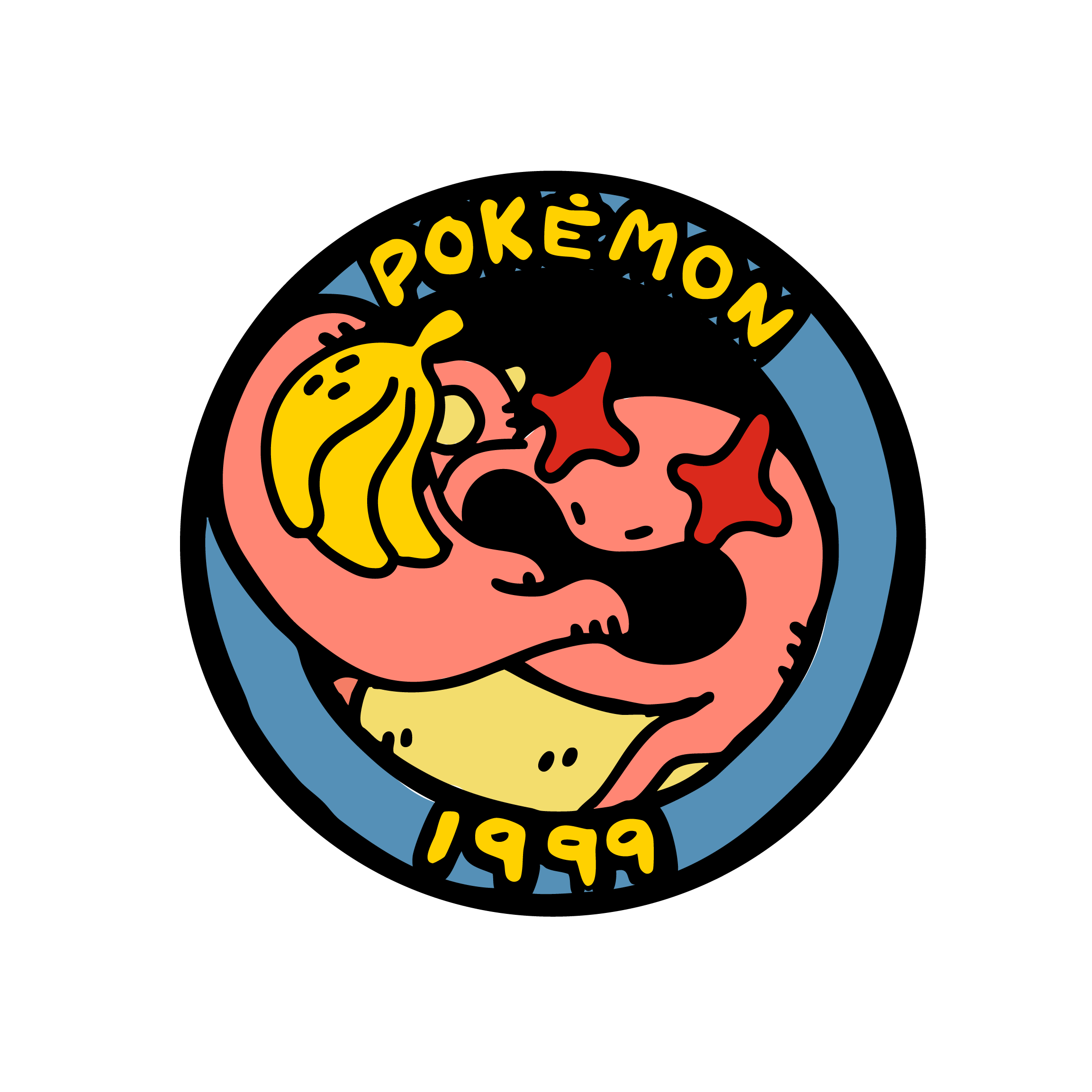
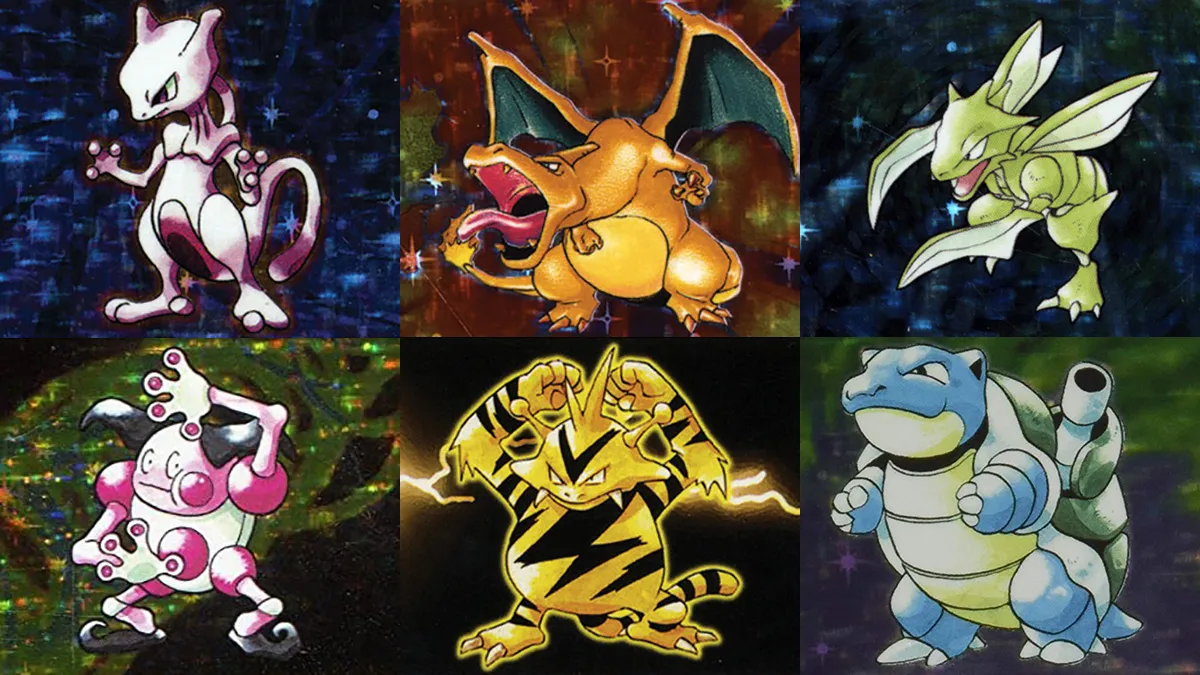
Leave a Reply